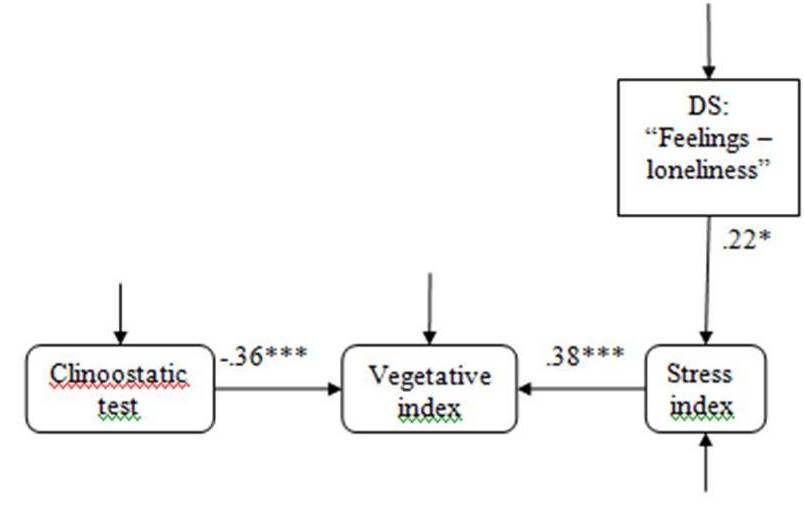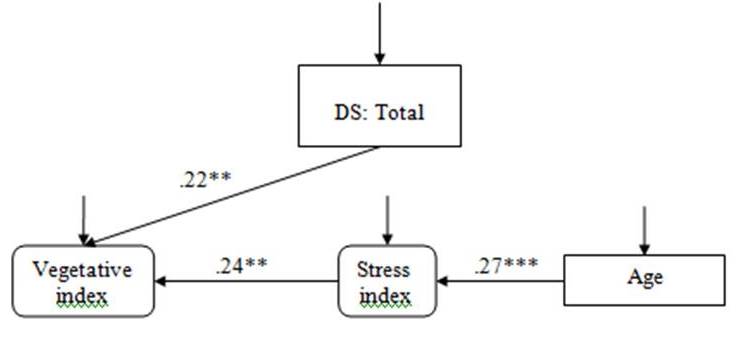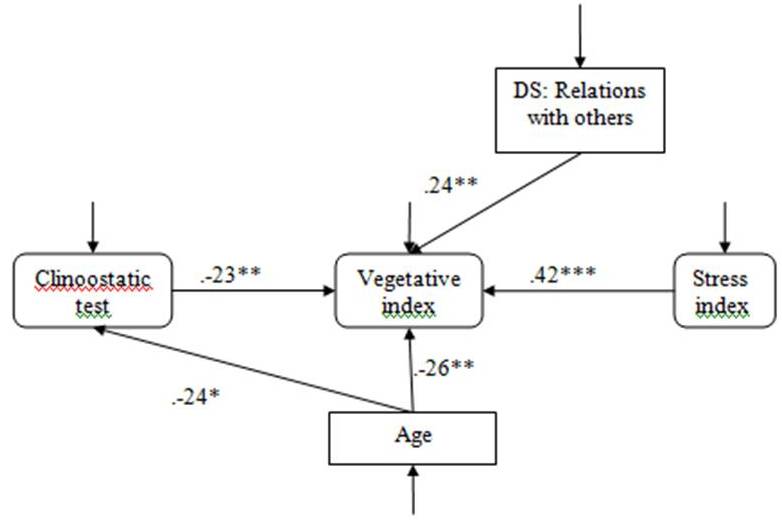Abstract
The presented study investigated the interrelationship between vegetative regulation and factors of daily stressors in adults. The objective was to determine paths of influence exerted by daily stressors on vegetative regulation in different periods of adulthood. Three hundred forty eight people aged 20-68 years (males – 126, females – 226) participated in the study. In order to calculate vegetative regulation index we used blood pressure levels; readings of the «AngioScan» device designed for assessment of the cardiovascular system condition and electrocardiography (ECG) parameters. Daily stressors were studied using a questionnaire “Daily Stressors” which revealed 10 types of daily stressors. We investigated factors of daily stressors, peculiarities of the vegetative status and stress index in the age groups of early, middle and late adulthood. The paper describes specifics of their manifestation in the age aspect. We revealed prevailing of the dominating type of vegetative index “sympathetic and parasympathetic effects balance” in a sample; parasympathetic effect in the groups of early and middle adulthood and intensified sympathetic effect in late adulthood. When analyzing the path model we found the direct effect of daily stressors on vegetative regulation and the reverse effect of the age in late adulthood. The study showed a cumulative effect of daily stressors in manifestation of ergotropy. Goodness measure values of the models confirmed their empiric correctness.
Keywords: Daily stressorsvegetative regulationсlinostatic testadult
Introduction
The life of the modern human is inseparably linked with periodical exposure to unfavorable factors which include daily stressors. Daily troubles (stressors) surround him from every quarter: family problems, minor nuisances associated with labor relations, feeling of loneliness, concern about relatives, financial difficulties, traffic congestions etc. The nature of such interaction is different. On the one hand, a person immersed in active life rhythm does not notice such effects and gets accustomed so that ceases to feel their intensity. On the other hand, absolutely insignificant events sometimes become critical for the human and cause a flow of negative emotions and experiences. The researchers working in the field of investigation of stress state that the accumulative effect of daily stressors may be more significant than consequences of serious life situations (Kuper, Dejv, & O’Drajskoll, 2007; O'Connor, Jones, Conner, McMillan, & Ferguson, 2008; Holahan & Holahan, 1987; DeLongis, Coyne, Dakof, Folkman, & Lazarus, 1987). They are able to cause disturbance of the somatic health (Harlamenkova, 2016); result in the higher psycho-emotional strain, promote the development of diseases (Sapolsky, 2002; Ganster & Rosen, 2013) have a negative impact on satisfaction with marriage (Totenhagen et al., 2012); mnemic processes (Stawski, Almeida, Lachman, & Tun, 2010). The negative effect exerted by stressors associated with the labor process (e.g., shift work), is manifested in social and family relations and also in disturbed sleep and rest rhythm (Centofanti, 2015; Van der Ploeg & Kleber, 2003; Frank & Ovens, 2002; Ward, Lombard, & Gwebushe, 2006). In spite of the interest to above problem, the influence exerted by daily stressors on the human psychophysiological state remains insufficiently studied. We decided to contribute to this field and consider features of the effect exerted by daily stressors on the physiologic peculiarities of adults.
Problem Statement
The investigation of physiologic peculiarities of the human organism associated with recovery process when experiencing daily stressors is an urgent scientific and practical task. There exists a close interrelationship between the psychic and somatic health. Physiologists found that the stress reaction was formed by the interrelations of the working organism and psychic activity, i.e. all organism systems: cardiovascular, endocrine, gastrointestinal and other systems were involved in the reaction to stress. Close co-existence of the sympathetic and parasympathetic parts of the vegetative nervous system and humoral factors provides for adaptation to changing conditions of the internal medium and the environment.
The studies performed within the limits of medical and preventive measures are evidence of the more frequent effects of stress events on the cardiovascular system activity (Thayer, Ahs, Fredrikson, Sollers, & Wager 2012; Lennartsson, Jonsdottirac, & Sjörsad, 2016). Therefore, physiologic values of the heart rate and pulse rate depend on many factors such as gender, age, presence of physical and emotional stresses, time of the day, body temperature, food intake and many others. The nature of reaction of the cardiovascular system to a stress situation is of great importance in assessment of the organism functional condition (Gouin, Deschênes, & Dugas, 2014). Different functional tests are used in order to assess the functional condition of the heart and vegetative mechanisms for cardiac rhythm regulation. The purpose of these tests is to elucidate the reaction of the vegetative nervous system to external stimuli.
Studying daily stressors in combination with vegetative regulation in adults will allow to extend the knowledge about the effect of daily stressors on the functional organism condition regarding vegetative regulation.
Research Questions
We made the following assumptions as a hypothesis of the study:
The intensity of daily stressors and stress index influence vegetative regulation so that they favor higher sympathetic effects and result in physiologic exhaustion.
Vegetative regulation is determined by the age and correlated negatively with the clinostatic test.
The pattern of relationship structure between daily stressors, stress index and vegetative regulation will be different in different age periods
Purpose of the Study
The purpose of this study was to investigate the paths of influence exerted by daily stressors on vegetative regulation in different adulthood periods; reveal types of vegetative regulation in a sample; study the interrelationship between vegetative index and daily stressors, results of clinostatic test and age; elucidate the role of the age and daily stressors in vegetative regulation.
Research Methods
Measures
A positive value is evidence of predomination of sympathetic influences, and a negative value reflects predomination of parasympathetic influences. Sympathiconia is characterized by predomination of dissimilation processes, extraversion, greater activity, i.e.
Findings
Daily stressors
The data on the intensity of daily stressor parameters in the age groups, means and standard deviations is presented in Table
The analysis of intensity of experiencing the stressor factors (Table
Physiologic characteristics
As concern physiologic parameters, we considered peculiarities of the cardiovascular system functioning in this part of the study. Table
We showed differences in the vascular age (p≤0.001). The differences were predictable because the minimum biological age was revealed in the early adulthood group. But some peculiarities should be noted. The comparative analysis of the age and vascular age parameters using t-test for one sample showed that the biological age in the first group exceeded the chronologic age (t=11.56, p=.000). The negative relationship was revealed in the study participants from the middle and older age groups, i.e. their biological age was less than the chronological age (t=-3.89, p=.000 and t=-9.53, p=.000, respectively). The lowest values of stress index were revealed in the representatives of the first group as compared to two older ages (p≤0.001). The analysis of systolic and diastolic blood pressure levels revealed significantly increased parameter values in the older age group (p≤0.001) what was also predictable and associated with age-related peculiarities.
Vegetative index
The study revealed significant difference in the vegetative index parameter in representatives of the older age group (p≤0.001). Isolated cases of sympathicotonia should be noted as a general trend. The data is presented in Table
Only 19 representatives from the third group had the normal type (20.4 %). On the one hand, the groups were characterized by considerable dispersion by some parameters, and on the other hand, a special position of the older age group was observed.
Path modelling
A path model 1 presented in Fig.

The path model 2 for the age group of middle adulthood period presented in Fig.

Prognostication of the negative influence exerted by daily stressors on the vegetative status in the older age group is presented in the path model 3 in Fig.

Conclusion
The study did not reveal any considerable differences in the intensity of daily stressors between the age groups except for the parameter «family problems»: the greater intensity was observed in the representatives of older ages. We found predomination of the normal type of vegetative regulation in representatives of the early and middle adulthood groups. It was shown that representatives from the later adulthood group were characterized by predomination of the type «pronounced parasympathicotonia».
The study revealed a negative correlation between vegetative coefficient and the age, positive correlation with the general parameter of daily stressors and negative correlation with the clinostatic test.
The following peculiarities were found in the age groups using the model analysis:
The effect of the stressor «Well-being - Loneliness» on the vegetative status through intensification of stress index favoring manifestation of ergotropy was detected in the early adulthood. The
The analysis of path models in the age groups elucidates the mechanisms of interaction between daily stressors and vegetative regulation promoting energy potential exhaustion depending on the age aspect. The obtained results emphasize the role of daily stressors in manifestation of ergotropy and set the problem of need to perform further studies in this field for researchers.
Acknowledgments
This research was supported by Russian Science Foundation, project 16-18-10088
References
- AngioScan. (n.d.) A new technology for health care and life span control. Early diagnosis of cardiovascular disease (CVD) is the main area of our research and development. Retrieved from https://www.angioscan.ru/en/
- Centofanti, S.A. (2015). The Impact of Split Shifts and Naps on Sleep, Performance and Mood. (Doctoral dissertation).
- Ganster, D.C. & Rosen, C.C. (2013). Work Stress and Employee Health: A Multidisciplinary Review Journal of Management, 39, (5), pp. 1085 – 1122.
- DeLongis, A., Coyne, J.C., Dakof, G., Folkman, S., Lazarus, R.S. (1982). The relationship of hassles, uplifts, and major life events to health status. Health Psychology, 1, 119-136.
- Frank, J.R., Ovens, H., (2002). Shiftwork and emergency medical practice. Canadian journal of Emergency Medicine. 4(6): 421-428. https://doi.org/10.1017/S1481803500007934
- Harlamenkova, N.E. (2016). Emocional'noe oskorblenie i prenebrezhenie i ego psihologicheskie posledstviya dlya lichnosti v raznye periody vzroslosti [Emotional abuse and neglect and its psychological consequences for personality in different periods of adulthood. Psychology of everyday and traumatic stress: threats, consequences, coping] (pp.193-215). In A.L.Z. Huravlev, E.A. Sergienko, N.V. Tarabrina, N.E. Harlamenkova (Eds.). Moscow: Publ. «Institut psihologii RAN».
- Holahan C.K., Holahan C.J. (1987). Life stress, hassles, and self-efficacy in ageing: A replication and extension. Journal of Applied Social Psychology, 17, 574–592.
- Gouin, J.P., Deschênes, S.S., & Dugas, M.J. (2014) Respiratory sinus arrhythmia during worry forecasts stress-related increases in psychological distress. Stress, 7(5): 416
- Kuper K., Dejv, F., O’Drajskoll, M. (2007). Organizacionnyj stress. Teorii, issledovaniya i prakticheskoe primenenie. [Organizational stress. Theories, research and practical application] Har'kov: Gumanitarnyj centr. (in Russian)
- Lennartsson, A.K., Jonsdottirac, I., Sjörsad, A. (2016) Lowheart rate variability in patients with clinical burnout. Int. J. Psychophysiol. https://dx.doi.org/10.1016/j.ijpsycho.2016.08.005
- Melnikova, S.V (2009). Vegetativnyj-indeks-kerdo-indeks-dlya-ocenki-vegetativnogo-tonusa-vychislyaemyj-iz-dannyh-krovoobrashcheniya [Vegetative-index-Kerdo-index-for-assessment-vegetative-tone-computed-from-blood-circulation data], Sports medicine (Ukraine), 1(2), 33-44.
- O'Connor, D. B., Jones, F., Conner, M., McMillan, B., Ferguson, E. (2008). Effects of daily hassles and eating style on eating behavior. Health Psychology .1, (Suppl). p. 20-31.
- Parfenov, A.S. (2013), Psychophysical potential of professional and applied preparation of student. Scientific notes of Orel State University. 4(54). 373-376.
- Petrash, M., Strizhickaya, O., Savenysheva, S., Golovej, L. (2018). Oprosnik povsednevnyh stressorov [Inventory of daily stressors] /Psihologicheskie issledovaniya, 11(57).
- Sapolsky, R. M. (2002). Endocrinology of the stress-response. In J. B. Becker, S. M. Breedlove, D. Crews, & M. M. McCarthy (Eds.), Behavioral endocrinology. 409-450.
- Stawski, R. S., Almeida, D. M., Lachman, M. E., Tun, P. A. (2010). Fluid Cognitive Ability Is Associated With Greater Exposure and Smaller Reactions to Daily Stressors. Psychology and Aging. 25(2), 330–342.
- Thayer, J.F., Ahs, F., Fredrikson, M., Sollers, J.J., Wager, T.D. (2012). A meta-analysis of heart rate variability and neuroimaging studies: Implications for heart rate variability as a marker of stress and health. Neuroscience and Biobehavioral Reviews 36(2) ,747–756. https://doi.org/10.1016/j.neubiorev.2011.11.009
- Totenhagen C.J., Serido J., Curran M.A., Butler F.A. Daily (2012). Hassles and Uplifts: A Diary Study on Understanding Relationship Quality. Journal of Family Psychology. 26(5), 719–728. https://doi.org/10.1037/a0029628
- Van der Ploeg, E., Kleber, R. (2003). Acute and chronic job stressors among ambulance personnel: predictors of health symptoms. Occupational and Environmental Medicine. 60 (Suppl1), 140-146.
- Ward, C. L., Lombard, C. J., & Gwebushe, N. (2006). Critical incident exposure in South African emergency services personnel: prevalence and associated mental health issues. Emergency Medicine Journal, 23(3), 226–231.
Copyright information

This work is licensed under a Creative Commons Attribution-NonCommercial-NoDerivatives 4.0 International License.
About this article
Publication Date
28 February 2019
Article Doi
eBook ISBN
978-1-80296-055-6
Publisher
Future Academy
Volume
56
Print ISBN (optional)
-
Edition Number
1st Edition
Pages
1-719
Subjects
Pedagogy, education, psychology, linguistics, social sciences
Cite this article as:
Petrash, M. D., Grebennikov, V. A., Strizhitskaya, O. Y., Savenysheva, S. S., Murtazina, I. R., & Golovey, L. A. (2019). The Effect Of Daily Stressors On Vegetative Regulation: The Age Aspect. In S. Ivanova, & I. Elkina (Eds.), Cognitive - Social, and Behavioural Sciences - icCSBs 2018, vol 56. European Proceedings of Social and Behavioural Sciences (pp. 145-154). Future Academy. https://doi.org/10.15405/epsbs.2019.02.02.17

